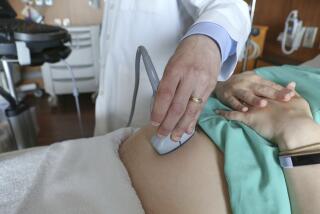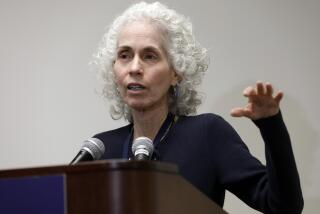County’s Dilemma: Cost vs. Care
- Share via
One night a few years ago, a man crashed his car into the side of Los Angeles County-USC Medical Center. In his hand, doctors recall, was a crumpled piece of paper from a local physician’s office. On it was a map showing how to get to the Boyle Heights hospital and the words: “You are having a heart attack. Go to County-USC.”
County-USC doctors recount this story to illustrate a dynamic that makes them both proud and frustrated: People who are turned away from other medical facilities for lack of funds come from across the region and the state, even from abroad, to L.A. County’s public hospitals for a wide range of essentially free medical care.
But the strain of caring for the poor and uninsured is forcing local officials to reconsider the amount of care they offer. The health department is asking the Board of Supervisors this week to adopt a strategy that would reduce the number of places patients can receive general medical care but, for the time being, preserve high-end hospital care and emergency rooms.
By doing that, the county will be attempting what critics say is an impossible balancing act--maintaining its commitment to take all comers, even while making it more difficult for patients to find medical help. It may also run the risk of flooding already overburdened emergency rooms with patients who have been unable to get basic medical care.
“We have been providing a higher level of services to the uninsured than any other county in this state,” Supervisor Gloria Molina said. “We’re going to have to downsize the number of services we provide. They’re just going to have to drive farther, wait longer.”
The supervisors will debate what would be the deepest cuts ever made to the $2.4-billion health department--closing nearly a dozen clinics, reducing beds at County-USC by more than 10%, and ending inpatient services at High Desert Hospital in the Antelope Valley.
More cuts, including the possible closure of emergency rooms, could come this fall, unless the federal government sends more funds to Los Angeles.
Though it has enough cash on hand to limp through another year, officials argue that the county cannot continue to provide the array of medical services it offers. The county faces an $800-million deficit by 2005 because of declining federal aid.
The county’s new health director, Dr. Thomas Garthwaite, said planners are trying to close clinics that offer predominantly nonspecialized services such as regular checkups and immunizations, while preserving sites that have more specialized treatments.
The thinking, Garthwaite said, is that the working poor who rely on the county may be able to pay for normal doctor’s appointments but not for pricier specialty care. “In this case, we’re caught between a rock and a hard place,” he said.
In addition, health officials are considering eliminating services that might not be included in a normal health plan, such as cosmetic surgery.
“I think the citizens and the government of L.A. County can be proud that they’ve had an open-door policy in regards to their health-care system,” Garthwaite said. “I’m not sure that is sustainable over the long run unless additional revenues can be generated. In a way, it becomes a magnet for patients that are uninsured.”
Health advocates say the proposed cuts will effectively end its open-door practice. “At a certain point you can say everyone has access to health care,” said Anthony Wright of the advocacy group Health Access, “but when you scale it down past a certain point, it’s a fraud.”
Wright gave the example of an uninsured person with diabetes who goes to county clinics for insulin shots. With fewer clinics and longer lines at those that remain, the diabetic may miss several needed treatments.
“It’s not just a matter of convenience,” Wright said. “It means people with diabetes get limbs amputated because they did not get their insulin.”
*
‘Care Rationing’
Mark Tarnawsky, a spokesman for the union that represents most of the health department’s 22,000 employees, said that closing clinics is akin to barring certain groups of people from hospitals.
“It’s a Darwinian kind of care rationing,” Tarnawsky said. “Let’s cram more people into small places and see who can get in first.”
Ana Mendoza of Compton wonders whether her family will be able to get in. For 10 years, they have gone to the Compton Health Center for regular medical care--checkups, TB shots, family planning and more. Mendoza’s 65-year-old mother goes there every month to get medicine for her dangerously high blood pressure.
That clinic is closing next week--it was cut by supervisors in February--and the family is being sent to another clinic, which supervisors are expected to vote to close this week.
“I don’t know what they are thinking,” Mendoza said. Eventually, she said, the only place for treatment will be the emergency room of Martin Luther King Jr.-Drew Medical Center in Watts, where waits can top five hours.
“People will just stay home and suffer, buy Tylenol,” predicted Mendoza, whose husband works but does not have health insurance.
Counties in California are responsible for providing medical care to those who cannot afford it, but the rules for who qualifies vary from county to county. Several counties, such as Los Angeles, provide an array of services to all who enter their medical system. But others, such as San Diego and Orange counties, provide more limited services to select parts of the population.
In Orange County, only families that earn up to twice the federal poverty level are eligible for treatment in select private hospitals that are under county contract. There they can receive treatment only to prevent death, disability or serious harm. The county does not offer pregnancy care, general checkups or optometry, for example.
San Diego treats only county residents who are U.S. citizens or legal residents who earn up to 12% above the federal poverty level, and also does not provide routine physicals or pregnancy services.
Los Angeles is not contemplating income limits such as those in Orange and San Diego counties.
John Wallace, a health department spokesman, said there was discussion in the planning process of how to keep out uninsured residents who earn more than 200% of the federal poverty level--12% of the 800,000 patients the county treats annually.
But planners realized that those patients could just go to the county’s emergency rooms, where federal law requires physicians to treat them, regardless of income or insurance status. (Orange and San Diego counties do not have this problem because they do not operate emergency rooms.)
Therefore, Wallace said, the only way to exclude higher-income, uninsured patients would be to end emergency service. “That’s something no one wants to do,” he said.
Indeed, the health department’s reductions are expected to increase pressure on its already overtaxed ERs. Patients who do not get preventive treatment at clinics will become sick and go to emergency rooms.
At County-USC, 90 beds are slated to be closed. The patients who would normally occupy those beds could end up waiting in the ER, predicted Dr. Ed Newton, vice chairman of the facility’s emergency medicine department.
*
Unmet Medical Care
It’s the county emergency rooms that absorb the brunt of the unmet medical care in Southern California.
The break room behind the County-USC emergency room is occasionally decorated with maps to the medical center from all parts of Los Angeles County, and even Mexico, similar to the paper carried by the man who crashed his car into the hospital.
Newton keeps a file in his office of such cases.
On stationery from an El Monte doctor’s office, a handwritten note states that the 63-year-old man carrying it suffers from coronary artery disease, elevated cardiac enzymes and an abnormal EKG--in other words, Newton said, a heart attack. “Needs treatment @ USC--thanks” reads the note.
Another scrawled note from a Diamond Bar physician: “To: LAC-USC Medical Center ER physician.... This patient needs admission and full workup; probable PTLA [angioplasty].”
Both cases, Newton said, should have been taken by ambulance to the nearest hospital rather than being told to drive to the distant County-USC. “It’s not that we’re objecting to seeing them,” he said. “It’s just the method [by which] they’re coming here.”
Newton and other emergency physicians at County-USC proudly tell stories of patients arriving from Belize or other countries, knowing that somewhere in East Los Angeles is a hospital that will care for anyone, no questions asked.
But, Newton acknowledged, such a reputation can be a double-edged sword. “There is satisfaction at being recognized as a destination that will take people in a very magnanimous way,” he said. “We are physicians here who will honor their Hippocratic oath.”
But, he added, “I understand it is an economic issue.”
More to Read
Sign up for Essential California
The most important California stories and recommendations in your inbox every morning.
You may occasionally receive promotional content from the Los Angeles Times.










